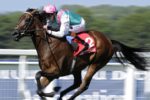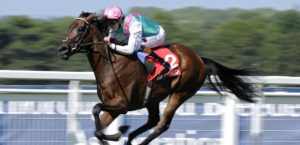In a year when racing suffered the loss of Sheikh Hamdan and Prince Khalid Abdullah, it can be argued that the acceleration of Najd Stud as a major buying force could not have come at a more opportune time.
Since July, the late Sheikh Hamdan’s Shadwell Estates has sold 403 horses through Tattersalls and Goffs under its own name, and catalogued around 80 to the various winter breeding stock sales in Kentucky, although plenty of those horses were withdrawn at the last minute. As Shadwell is scaled back worldwide, it follows that no purchases are being made at public auction.
Against that, 2021 was a year when the buying power of Saudi Arabian interests came into sharper focus. Their interest is nothing new – such buyers have long regularly replenished their stock out of North America and Europe – but it has to be said that the ambition for Saudi Arabia to sit at racing’s top table has never been stronger, and that desire to improve racing in the region is now reaping rewards. The $35.1 million Saudi Cup meeting, now in its third year, is naturally helping drive that ambition forward, with its lucrative purses key in attracting a wide range of international runners.
However, it isn’t all about that one Saturday meeting in February.
The Saudi Jockey Club hosts a total of 90 meetings this season at the King Abdulaziz Racecourse in Riyadh, up from 64 last season. The launch of another racecourse is also reportedly being planned. More meetings naturally fuels the need for more horses.
There is a robust breeding programme in Saudi Arabia, supported by recent expensive stallion purchases such as Siskin’s sire First Defence. However, interest in the acquisition of proven quality racing stock also appears to be on the rise.
For instance, Saudi Arabian buyers accounted for 121 horses – worth 12,281,500gns – at Tattersalls last year. Chief among them were Prince Faisal bin Khaled Al Saud’s Najd Stud, which came away with 2,791,000gns worth of horses in conjunction with Peter and Ross Doyle at the Tattersalls Autumn Horses in Training Sale, including the 700,000gns sale-topper Grocer Jack. That particular horse, a Group 3 winner in Germany, is now with William Haggas but other purchases such as My Frankel (310,000gns) and Third Kingdom (135,000gns) were shipped straight to Saudi Arabia, where they have already been successful.
Najd Stud was back in action at last month’s Tattersalls February Sale, where 310,000gns worth of purchases included the Group 3-placed Wuqood, bought for 170,000gns, and at the Goffs February Sale, where as leading buyer it came away with seven yearlings and one three-year-old filly worth a total of €288,000.
Michael Donohoe of the BBA Ireland is also a regular purchaser of stock on behalf of Saudi Arabian interests, and his acquisitions on behalf of such clients last year included the Vertem Futurity fourth Hannibal Barca, bought for 500,000gns.
Nor are the desires of Saudi Arabian interests refined to proven horses. Breeze-up sales have also benefitted from their participation, with the second top-rated Saudi three-year-old Almuthanna a graduate of Florida’s OBS March Sale and two-time winner Street Boy having been purchased for 110,000gns out of last year’s Tattersalls Craven Sale. Perhaps the latter’s success will help to spur on interest at this year’s round of European two-year-old auctions. In the meantime, there is reportedly hope of Saudi Arabian participation at this month’s inaugural Goffs Dubai Breeze-Up Sale at Meydan.
A GRAND SERVANT
There was some sad news last month with the announcement that ill health had forced the retirement of Le Havre from stud duty.
The 16-year-old son of Noverre is proof of how the strong support of an owner-breeder, in his case Gerard Augustin-Normand, can be influential in launching a stallion. In turn, Le Havre can also be credited as a driving force behind the rise of Augustin-Normand’s racing fortunes and the horse’s base of Montfort et Preaux in Normandy, which operates today under Nurlan Bizakov’s Sumbe banner.
Le Havre’s retirement to stud in 2010 coincided with a lull in the French stallion ranks, exacerbated by the retirements or deaths of stalwarts such as Linamix, Highest Honor and Anabaa. But from his first runners onwards, Le Havre did his bit to fill that void to the extent that today his record consists of 50 stakes winners, five of them – including Chris Wright’s excellent mare Wonderful Tonight – at Group 1 level.
It is testament to the support of Augustin-Normand, as well as the management of his advisor Sylvain Vidal, that eight of Le Havre’s Group winners have been bred at Montfort et Preaux (or Haras de la Cauviniere as it was known until 2017), among them the Poule d’Essai des Pouliches and Prix de Diane heroines Avenir Certain and La Cressionniere.
Le Havre is starting to make an impact through his daughters, one of them being La Pyle, the dam of Pyledriver. However, with only two minor sons at stud in France, it is unlikely that his sire line will take hold and with that, access to that descending from Blushing Groom diminishes even further. Once a powerful line responsible for Rainbow Quest, Nashwan and Le Havre’s grandsire Rahy, it today hangs by a thread, its fortunes resting on the likes of Rio De La Plata in France and Bago and Animal Kingdom in Japan.



